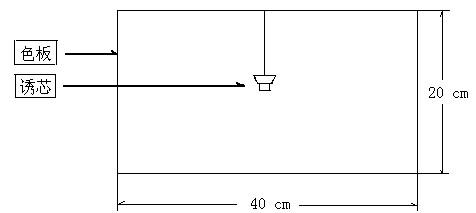A method of trapping and preventing tea aphids
A tea aphid and trapping technology is applied in the fields of pest control, botanical equipment and methods, and devices for catching or killing insects. Reduction in the frequency of use and dosage, high efficiency
- Summary
- Abstract
- Description
- Claims
- Application Information
AI Technical Summary
Problems solved by technology
Method used
Image
Examples
Embodiment 1
[0021] Step 1: Separation and identification of volatile components of different varieties of tea trees
[0022] Use the air entrainment adsorption method. Put the potted tea tree plant part in a clean glass cover, let in clean air from the air inlet to take away the smell, flow through the Super Q column connected to the air outlet, wash the Super Q column with organic solvent, and slow down under nitrogen flow. Slowly concentrate the eluate to 20 left and right, take 1 , by GC-MS analysis, and with standard samples, 13 components in the volatiles of Longjing tea tree were identified: trans-2-hexenal, cis-3-hexen-1-ol, cis-3-hexenal ethylene acetate, 2-ethylhexanol, - Ocimene, Linalool, Nonanol, Cis-Hexenyl Butyrate, Decylal, Myristyl, Caryophyllene, Geraniol, and Hexadecane. By the same method, 13 components were isolated and identified from the volatiles of the whole Anji white tea plant: trans-2-hexenal, cis-3-hexen-1-ol, cis-3-hexene acetate, 2-Ethylhexanol, ...
Embodiment 2
[0047] In 2010, in Meijiawu, one of the origins of West Lake Longjing, a tea garden with an area of 1.3 hectares was selected. This tea garden is located in the mountains and forests, and generally no pesticides are used to control diseases and insect pests. Divide it into two parts, 300 meters apart. Part of it is a trapping area with an area of 3300 m 2 , on March 20, May 20, August 20, and September 20, 100 tea aphid plant-derived pheromone traps were evenly placed, and the color plates were jasmine yellow plastic sticky plates, with an interval of 7 m 8 m; the other part is the control without control. On March 30th, May 30th, August 30th, and September 30th when tea aphids migrated and flew, samples were taken at five points in the trapping area and the control area, each point was a 4-meter-long tea row, randomly 40 tea shoots were surveyed, 200 shoots were surveyed in each district each time, and the percentage of bud shoots with tea aphids was calculated (Table...
Embodiment 3
[0051] In April 2010, when the tea aphid was at its peak, another tea garden with an area of 1.2 hectares was selected in Meijiawu, which was divided into two parts with a distance of 200 meters in the middle, and one part was used as a trapping area with an area of about 3300 m 2 , on April 20, when the aphids peaked, 100 tea aphid plant-derived pheromone traps were evenly placed, the color board was bud green plastic sticky board, and the interval was 7 m 8 m; the other part is the control without traps. May 1st is the season when the population density of tea aphids in Meijiawu tea garden is the highest. Samples were taken at five points in the trapping area and the control area. Investigate 200 shoots and calculate the percentage of shoots with tea aphids (Table 2). In late spring, tea aphids are caught at their peak, which has a significant restrictive effect.
[0052] .
PUM
 Login to View More
Login to View More Abstract
Description
Claims
Application Information
 Login to View More
Login to View More - R&D
- Intellectual Property
- Life Sciences
- Materials
- Tech Scout
- Unparalleled Data Quality
- Higher Quality Content
- 60% Fewer Hallucinations
Browse by: Latest US Patents, China's latest patents, Technical Efficacy Thesaurus, Application Domain, Technology Topic, Popular Technical Reports.
© 2025 PatSnap. All rights reserved.Legal|Privacy policy|Modern Slavery Act Transparency Statement|Sitemap|About US| Contact US: help@patsnap.com


